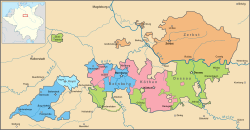Principality of Anhalt-Zerbst
Principality of Anhalt-Zerbst Fürstentum Anhalt-Zerbst (German) | |||||||||||||
|---|---|---|---|---|---|---|---|---|---|---|---|---|---|
| 1252–1396 1544–1796 | |||||||||||||
 Anhalt principalities (1747-1793), Zerbst in orange | |||||||||||||
| Status | State of the Holy Roman Empire | ||||||||||||
| Capital | Zerbst | ||||||||||||
| Common languages | Upper Saxon | ||||||||||||
| Government | Principality | ||||||||||||
| Historical era | Middle Ages | ||||||||||||
• Partitioned from Anhalt | 1252 | ||||||||||||
1396 | |||||||||||||
• Partitioned from Anhalt-Dessau | 1544 | ||||||||||||
• Partitioned1 | 1603 | ||||||||||||
• Partitioned2 | 1667 | ||||||||||||
| 1796 | |||||||||||||
• Duchy of Anhalt reunited | 1863 | ||||||||||||
| |||||||||||||
1: In 1603, Anhalt-Zerbst lost territory to Anhalt-Dessau, Anhalt-Bernburg, Anhalt-Plötzkau and Anhalt-Köthen. 2: In 1667, Anhalt-Zerbst lost territory to create Anhalt-Mühlingen and Anhalt-Dornburg. | |||||||||||||
Anhalt-Zerbst was a principality of the Holy Roman Empire ruled by the House of Ascania, with its residence at Zerbst in present-day Saxony-Anhalt. It emerged as a subdivision of the Principality of Anhalt from 1252 until 1396, when it was divided into the principalities of Anhalt-Dessau and Anhalt-Köthen. Recreated in 1544, Anhalt-Zerbst finally was partitioned between Anhalt-Dessau, Anhalt-Köthen, and Anhalt-Bernburg in 1796 upon the extinction of the line.
History
It was created when the Anhalt territory was divided among the sons of Prince Henry I into the principalities of Anhalt-Aschersleben, Anhalt-Bernburg and Anhalt-Zerbst in 1252. In the course of the partition, Prince Siegfried I, the youngest son of Henry I, received the lands around Köthen, Dessau, and Zerbst. His son and successor Prince Albert I took his residence at Köthen Castle in 1295. In 1396, the surviving sons of Prince John II of Anhalt-Zerbst again divided their heritage: Sigismund I became Prince of Anhalt-Dessau and his younger brother Albert IV went on to rule as Prince of Anhalt-Köthen.

The principality was recreated, when in 1544 the heirs of Prince Ernest I of Anhalt-Dessau divided their territory and the eldest surviving son, Prince John V, took his residence at Zerbst Castle. The second incarnation, however, lost a lot of territory in 1603 when it was partitioned for a second time with some of its territory being given to Anhalt-Dessau, Anhalt-Bernburg, Anhalt-Plötzkau and Anhalt-Köthen.
By 1606, all Anhalt principalities had turned to the Reformed faith, however, Anhalt-Zerbst returned to Lutheranism in 1644. In 1667, Prince John VI inherited the remote Lordship of Jever in East Frisia. Upon his death in the same year, however, Anhalt-Zerbst lost more of its territory, with Anhalt-Mühlingen and Anhalt-Dornburg being created. The Jever lordship was administrated by Ascanian relatives, it was hit hard by the Christmas Flood of 1717.
The last Prince of Anhalt-Zerbst, Frederick Augustus was forced into exile, when Prussian forces invaded Anhalt during the Seven Years' War in 1758. Upon his death in 1793, the Principality of Anhalt-Zerbst came to an end with its territory being divided among the Ascanian princes of Anhalt-Dessau, Anhalt-Köthen, and Anhalt-Bernburg.
Princes of Anhalt-Zerbst

Princes, 1252–1396
- Siegfried I 1252–1298
- Albert I 1298–1316
- Albert II 1316–1362
- Albert III 1359 (co-regent)
- Waldemar I 1316–1368 (co-regent)
- Johann II 1362–1382
- Waldemar II 1368–1371 (co-regent)
- Waldemar III 1382–1391 (co-regent)
- Sigismund I 1382–1396 (co-regent)
- Albert IV 1382–1396 (co-regent)
Partitioned between Anhalt-Dessau and Anhalt-Köthen in 1396.
Princes, 1544–1796
- Johann V 1544–1551
- Karl I 1551–1561
- Bernhard VII 1551–1570 (co-regent)
- Joachim Ernest 1551–1586 (co-regent, later sole ruler; he unified all the Anhalt lands); later, his sons divided again Anhalt.
- Rudolph 1603–1621
- Johann VI 1621–1667
- Augustus of Anhalt-Plötzkau regent 1621–1642
- Karl William 1667–1718
- Sophie Auguste of Schleswig-Holstein-Gottorp regent 1667–1674
- Johann August 1718–1742
- Johann Ludwig II 1742–1746
- Christian Augustus 1742–1747 (co-regent)
- Friedrich August 1747–1793
- Joanna Elisabeth of Holstein-Gottorp regent 1747–1752
- Sophie Auguste Fredericke (Empress Catherine II of Russia) 1793–1796 (only in Jever)
To Anhalt-Dessau 1796.
See also
References
- House of Ascania
- Princes of Anhalt-Zerbst
- Lists of princes
- History of Anhalt
- Principalities of the Holy Roman Empire
- Upper Saxon Circle
- 1252 establishments in the Holy Roman Empire
- 1396 disestablishments in the Holy Roman Empire
- States and territories established in 1544
- 1544 establishments in the Holy Roman Empire
- 1796 disestablishments in the Holy Roman Empire
- Former states and territories of Saxony-Anhalt


